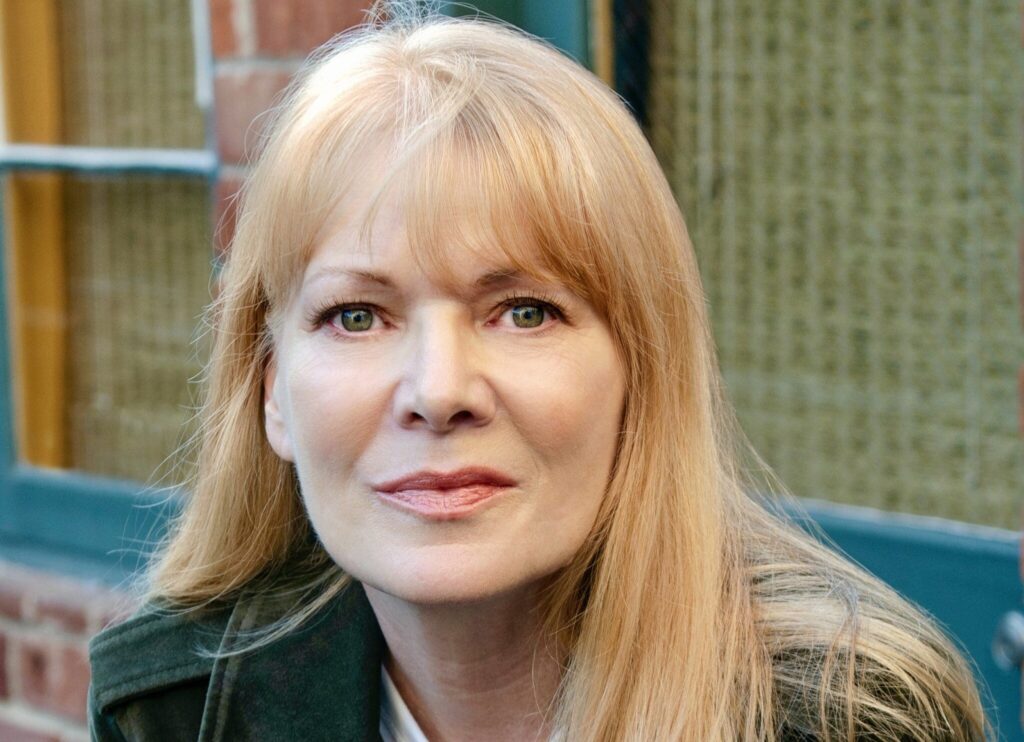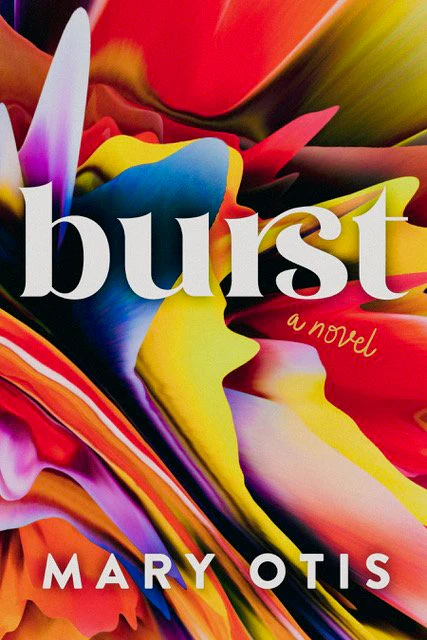In her debut novel, Burst, Mary Otis traces the tumultuous lives and conflicted bond of a mother and daughter navigating the world without a robust community or safety net: they are “alone but together.” Charlotte’s eccentric, sometimes erratic behavior both enchants and repels her daughter, Viva, who seeks structure and security through a single-minded dedication to her passion for dance. But this mother-daughter duo is more alike—and more connected—than they can sometimes understand, and Otis locates the poignancy of their parallel lives with insight and compassion.
Moving seamlessly between perspectives and over years, Burst elegantly examines the complexity of this archetypically fraught relationship, the intergenerational snare of addiction, and the desire for a life driven by creativity and self-expression. The novel begins in Massachusetts, where Otis grew up. She now lives in Los Angeles.
Otis is also the author of a short story collection, Yes, Yes, Cherries. She was a founding professor in the UC Riverside Low-Residency MFA in Creative Writing and has taught at UCLA. Her writing has appeared in Electric Literature, McSweeney’s, the Los Angeles Times, and ZYZZYVA, among other publications.
This interview is based on a conversation held at Mrs. Dalloway’s bookstore in Berkeley and has been edited for clarity and length.
LAURA COGAN: This moment has something of a full-circle quality to it, because you sent ZYZZYVA a wonderful short story called “Flight,” about a mother and daughter spending a Cape Cod summer camping near the beach. And here we are, celebrating the publication of your novel about that same mother and daughter. I’d love to hear how this all developed for you over the years, and how you knew this story could become a novel.
MARY OTIS: Once “Flight” was published, I thought I had finished exploring the characters of Viva and Charlotte. Then one day, I was walking, which is integral to my writing process, and a passage from the mother’s [Charlotte’s] point of view came to me. This was a shock, as the story was completely from the daughter’s point of view. I sat down that day and wrote a chapter that illuminates a pivotal shift in the novel—interestingly, one near the end. After that, several passages and scenes came to me quickly, all out of order, but significant to the story, and most of them never changed from the original draft. I’m always interested in how consciousness runs counter to the lived experiences of my characters, and that was certainly how the initial material for Burst appeared. During the time I was writing Burst, I was also publishing stories and essays, so creative “sorting” was paramount relative to deciding which form would best support each idea. It became clear that with the amount of material I was writing for Burst, it was destined to become a novel.
LC: Reflecting on Burst, I felt I could see your expertise as a crafter of short stories. You locate just the right moments to dwell on to capture the essence of these lives. And the book also allows for ambiguity and ambivalence around the central relationship, which—in a book centered around a complex mother-daughter dynamic—has the added advantage of feeling really authentic. Did you find yourself thinking about how the form would shape the story of these women? Did the experience of writing this first novel after writing so many short stories illuminate anything new for you about either genre?
MO: Writing a short story is like running down a balance beam in that you need to focus on your throughline and not veer off into side stories and subplots. This is a challenging task that I enjoy tremendously. However, a novel affords a writer so much more creative real estate.
One of the themes that runs through the book is the malleability of memory and how the past interrupts the present, or as Faulkner said, “The past is never dead, it’s not even past.” By using a nonlinear structure for part of the novel, I had the ability to cut back and forth in time and cover a sweep of three decades.
LC: Let’s talk about this relationship between Charlotte, the mother, and Viva, the daughter. There’s so much to discuss, but maybe we can start here: I read this as a lifelong love story. Their relationship is possessive and intense, and certainly there’s pain and conflict. But to my reading, Viva and Charlotte are, for all their struggles, profoundly bonded throughout. Is that how you see them?
MO: Yes, I do. Theirs is a complex relationship, one that while sometimes fractious also hinges on vulnerability, humor, and intense loyalty. The writer Willa Cather said, “The heart of another is a dark forest, always, no matter how close it has been to one’s own.” Arguably, parental relationships might be considered some of the closest, and yet in Burst, some of Cather’s sentiment rings true. Charlotte is a deeply mysterious and private person, and I think there are probably things I’ve yet to discover about her! Additionally, while Charlotte can be unpredictable and unreliable, one might consider, in the most positive sense, that she gives her daughter the gift of the opportunity to define herself.
LC: While mother-daughter relationships are famously fraught, a rarely acknowledged aspect of what makes them so challenging is that it’s a relationship that needs to be flexible and durable so that it can accommodate the changing identities of both people as they grow up and age. It’s a relationship that has to transform fairly radically over the years. Is part of what you’re exploring here the kind of endurance and continued willingness to try and try again that is at the heart of any lifelong intimacy?
MO: I love that you use that word “durable,” as it applies to relationships, one that is often overlooked. When we’re young we’re taught via cultural mores, messaging, and stories that significant relationships like that of a parent/child relationship or a spouse are destination points rather than starting points relative to the necessity to be flexible and adapt over the years. In terms of Viva and Charlotte, there are moments when, although they try to pull away from each other, they’re unable to, and there are turning points of willingness and grace for both characters. The idea that they would ever abandon each other is not an option.
LC: I was also really interested in the book’s exploration of long-term effects of major physical injuries. With both Charlotte and Viva, there seems to be a suggestion that physical traumas can become emotional traumas that persist and shape a person’s psyche in complex ways long after the body has healed.
MO: As the result of a riding accident, Charlotte has a “broken” mouth, which, though it heals, later manifests as an inability to artistically express herself. Later still, she experiences a puzzling and distressing condition where she continually hears music that no one else does. It’s almost as if her self-expression has turned completely inward. Viva also experiences a significant physical injury that will permanently affect the course of her career. During the writing of Burst I came across a fascinating study about how intergenerational trauma manifests psychically and physically, and that informed some of my thinking as to how to illuminate and dramatize that topic within this novel.
LC: One of the tensions of the book is Viva’s desire or determination to never be like her mother. There seems to be a suggestion that defining oneself in opposition to something or someone else can have unintended consequences—and that maybe mothers and daughters are likely to find themselves at similar crossroads eventually, even if they arrive there via wildly different paths. Is that something you had in mind early on, or did Viva surprise you? And, more broadly, was there anything that surprised you about these characters as you lived with them and developed them over the years?
MO: There were numerous things that surprised me about both Viva and Charlotte. While I need to feel a strong pull to write about a character before I begin, I usually know only a few things about them. If I try to assign personality traits and past experiences too early, I’m not sure they’ll live on the page. Early on, I didn’t know Viva would become a dancer, that dance would become the organizing principle of her life. I had no idea about Charlotte’s backstory when I began the book, but the chapters I later wrote speak to it, and I appreciate that readers have told me those helped them understand her more fully. As with people in real life, the longer you know a character, the more they may surprise you.
LC: Burst is in conversation with a variety of art forms: dance, photography, painting, and also teaching. Is that something that feeds your own writing—the exploration and discovery of other art forms?
MO: Absolutely. I often listen to certain pieces of music while working on a project, and I like to look at photographs and paintings that serve as creative talismans. In the writing of Burst, I was compelled by the task of working with words to illuminate various art forms. It’s important to me to try and present any art form with veracity, depth, and in the case of dance, physicality. One of the further issues I explore in Burst is how artistic rigor can lead to transcendence, and yet, when artistic impulse is thwarted, that energy can sometimes express itself in destructive ways. A theme that runs through the book—the risks inherent in addiction—ultimately also speaks to the necessary risks that need to be taken as an artist. And, while Viva pursues her art, one might consider Charlotte an artist without an art form.
LC: Early in the book, Viva discovers through a chance encounter at the campground near the beach that she can experience a kind of transcendence through dance. I was struck by how true that scene felt, how one interaction (and especially a moment of encouragement) can have a lasting effect. And that seems connected to a theme that you handle with a lot of sensitivity—which is the yearning for a creative life, and how relatable that is, and how easily broken or disappointed those dreams are. Is that something that was on your mind, perhaps both as a writer and a teacher?
MO: The yearning for a creative life and the way one expresses oneself through a particular art form can have an alchemical aspect—or, as Borges said, “Art is fire plus algebra.” Viva has an encounter with one person whom she will never see again, a woman who says something to her that changes everything and sets her on a career path. Like many artists’ beginnings, Viva’s early life presented little indication that she would go in this direction, but as Viva begins to grow and thrive as a dancer, people come into her orbit who greatly support her journey as an artist. I’ve been the beneficiary of that kind of support myself, and I’ve been mindful of returning it as a teacher. One of the greatest gifts anyone can give a potential artist is to not only recognize talent, but to aid and abet that artist on their journey to its fullest expression.


